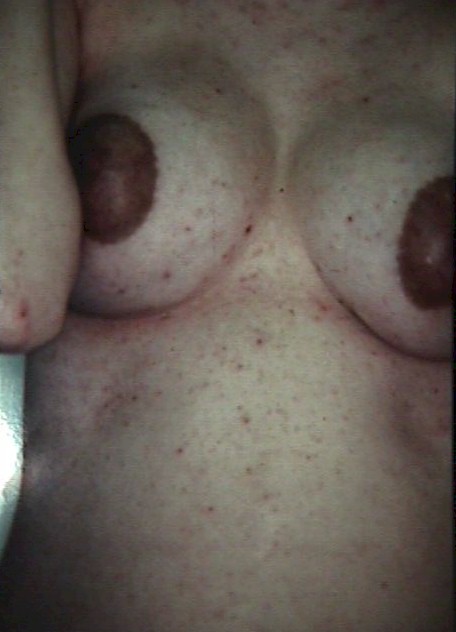|
Scabies |

 Scabies is a skin infection with small (1/2 mm) mites, Sarcoptes scabiei.
Scabies is a skin infection with small (1/2 mm) mites, Sarcoptes scabiei.
The mites burrow into the skin, laying their eggs in a trail behind them. About a month after the infection, there is a hypersensitivity skin reaction, with raised, intensely itchy skin lesions, most noticeable at night.
The burrows (tunnels) from the mites can be seen through the skin as thin, serpentine, scaly lines of up to 1 cm in length. They are most commonly found in the fingerwebs, elbows, axilla, and inner surface of the wrists. They are also seen commonly on the breast areolae of women and along the belt line and genitals of men.
The infection is spread by skin-to-skin contact with an infected person.
The diagnosis is made by visualizing a burrow and confirmed by microscopic visualization of the mite, ova or fecal pellets in scrapings of the burrow suspended in oil.
Treatment is:
- 5% permethrin cream (Nix, Elimite) applied to the skin from the neck down and left in place for 10 to 14 hours before washing off. Itching may persist for up to one month and should not be viewed as an indicator of failed treatment.
- If permethrin is not available, 1% lindane(Kwell lotion or shampoo) once after showering and left in place for 10 minutes before rinsing. This may be repeated in 7 days if necessary. Do not use more often or longer than this as lindane has neurotoxicity potential.
- Diphenhydramine 25-50 mg PO every 6 hours will relieve some of the itching, but will make the patient sleepy.
- In severe cases, Prednisone 40 mg PO QD X 2 days, then 20 mg X 2 days, then 10 mg X 2 days will provide significant relief. This regimen should be used cautiously in operational environments as it will suppress the immune system, making the patient more vulnerable to other problems.
Unlike pubic lice, Sarcoptes scabiei do not live long on clothing or bed linens.